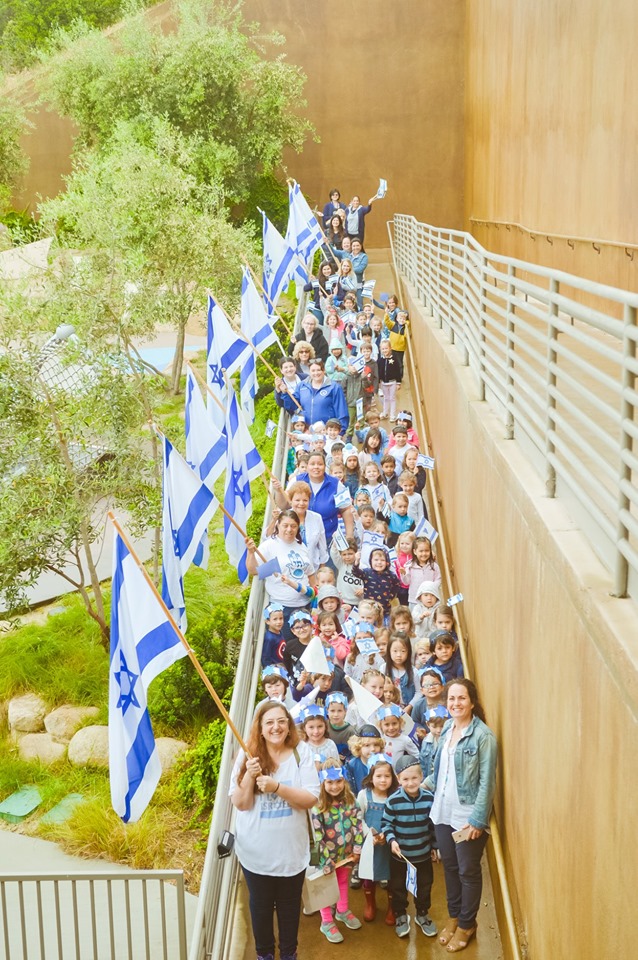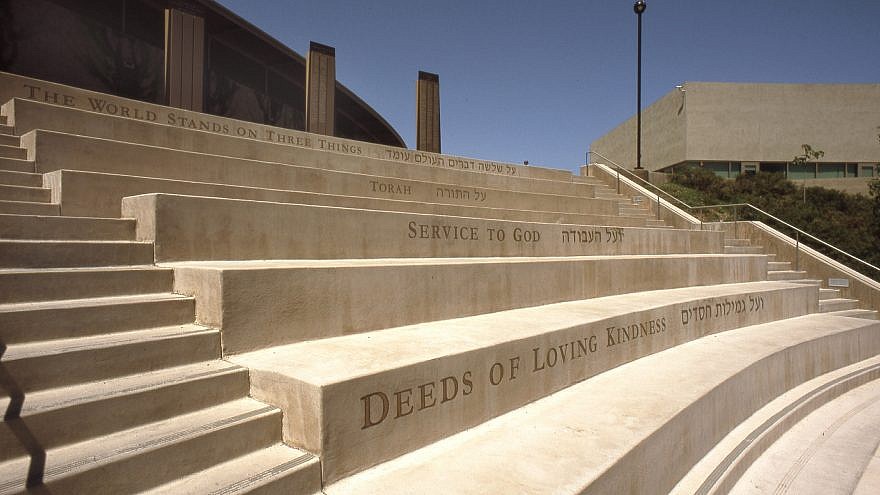When students returned to the San Diego Jewish Academy just a few weeks ago, they were greeted not only by new teachers, but new classmates as well.
“For the coming school year, we have a total of 600 to 625 students—a significant increase over last year,” said head of school Chaim Heller.
Fueling the increase in enrollment is “Open Door,” a new initiative that is lowering the cost of tuition for students entering kindergarten and ninth grade at the K-12 pluralistic school. Under this plan, tuition for students in those two grades is half-price; a discount that will continue for the next four years. They also offer a discounted tuition rate for Jewish communal employees who might otherwise not be able to afford to send their kids there.
Base price for the elementary school starts at $24,000.
And once they looked, Heller said, they might be more inclined to give the school—with its 56-acre campus, view of the Pacific Ocean, performing-arts studio and walking trails—a try.
Among those who liked what they saw were Jennifer and Zach Millrood, whose 6-year-old son Sebastian started kindergarten this year. The couple had toured the school and two other non-Jewish schools before making their decision.

“We wanted the Jewish education—that was really important. We toured the school before we knew about the tuition assistance and really liked it, and once we found out [tuition] was half price, that sealed the deal,” says Jennifer Millrood, adding that two of their friends are also sending their children to SDJA, drawn in by the low-cost option. “They weren’t considering private school, but with such an exceptional value, they decided to send their kids to the academy.”
The ‘value proposition of day schools’
The success at SDJA—where this year’s ninth-grade class includes almost every eighth-grade graduate from May; traditionally up to 30 percent go on to other high schools—and at a number of other Jewish day schools belies an increasing concern and trend seen elsewhere: a decreasing enrollment in existing schools and decreasing number of Jewish day schools overall.
The only place where an uptick in enrollment overall has been reported is among the Orthodox haredi and Chassidic communities that primarily only send their children to yeshivahs and Bais Yaakov-style schools, which offer substantial Jewish learning along with secular subjects, and separate classes or school buildings for boys and girls.

The overall Jewish enrollment struggle comes as the community becomes less and less affiliated with traditional communal organizations, including synagogues.
According to the “A Portrait of Jewish Americans,” a 2013 Pew Research Study, 20 percent of Jews surveyed said they have no religion, and a similar percent said that Judaism is not important to them. The same study found that “overall, 25 percent of Jewish parents say they have a child who was enrolled in a yeshivah or Jewish day school in the past year.”
The Day School Census Report 2013-14, issued by the Avi Chai Foundation, found that 34,000 students attended a non-Orthodox day school, making up just 13 percent of all Jewish day-school attendees. By contrast, the census in 2003 showed 39,500 students in non-Orthodox day schools. A new report is expected at the end of 2019, though experts believe they know what they will find.
“In broad strokes, we are going to see the continuation of what we saw five years ago,” says Dan Perla, director of financial vitality at Prizmah: Center for Jewish Day Schools. “Right-wing and centrist Orthodox schools will continue to grow; Modern Orthodox schools will be flattish, with maybe a couple of points up or down; and non-Orthodox schools will continue to decline. We are seeing an increase in that decline.”
Jack Wertheimer, the Joseph and Martha Mendelson Professor of American Jewish History at the Jewish Theological Seminary, agrees that the report is likely to show a decline in enrollment at non-Orthodox schools.

“There was a time when Jewish day schools were seen and valued for the content they delivered, the language skills and the knowledge that was transmitted, but as time has gone on and the thinking about education has progressed in the wider world of American education, that has influenced parents at day schools,” he says. “As a result, they are demanding far more sophisticated STEM programs; an expansion of music, art and cultural expression; and demanding that day schools provide a great deal of personal attention, including tutoring, and social and emotional support.”
The result is that Jewish day schools are increasing staff and hiring for positions they never had before, including counselors, psychologists and more, which translates into higher educational costs and higher tuition fees.
“I think it’s fair to say that day-school tuition costs absorb a higher level of a family’s income than it did 20 or 30 years ago,” says Wertheimer, noting that some parents therefore struggle with the “value proposition of day schools.”
“Is it worth it to spend $20,000 or $30,000 for each child we are sending to school? In those sectors of the Jewish community where day-school education is seen as optional as opposed to mandatory or a necessity, there will be those who come to the conclusion that it is not worth the cost.”
‘Tuition incentive a significant factor’
While it is a challenging environment to operating in, Jewish day schools are not throwing in the towel by any means. They are finding new ways to interest young families to join them. Some have created specific financial incentives for Jewish communal professionals to send their children to day schools. Others are offering tours, allowing members of the community to see what goes on during the school day.
Many have invested in upgrading their educational offerings, including creating STEM (science, technology, engineering and mathematics) labs where students can learn robotics, 3-D printing and other skills.
Some schools are opening their doors to interfaith families and telling them, “Your children are welcome here, and we would be delighted to integrate our children into our schools. That is paying off in some day-school communities,” says Wertheimer.
Others are opening their doors to non-Jewish families outright—focusing on Hebrew language, the culture of Judaism and the global society in which their students belong. At San Diego Jewish Academy, for instance, which has an “international school,” there is a contingent of students who come from China to attend the SDJA’s high school division.
“The students study with us, with four or five international students per grade,” says SDJA’s Heller. “They give our kids a global perspective and sense that they are not alone on the planet. The Chinese students are fantastic; they come to our school because they see it as a way to get into schools like University of California, Berkeley or the University of Chicago.”
Others are trying innovative programs like “personalized learning,” utilizing the online Summit Learning Platform, for example, which focuses on cognitive skills and content knowledge. In schools that utilize this platform, the day is divided into focus areas for personal learning and project-based learning time, where they show the mastery of the lessons learned. The platform, educators say, provides students with ownership of their learning. Among the schools using the Summit Platform are the Fuchs Mizrachi School in Beachwood, Ohio, and Bader Hillel High in Milwaukee.
And is lowering tuition costs a path to success?
According to Prizmah’s Perla, “the evidence is mixed.”
He points to successfully run programs like the tuition program at the Anne and Max Tanenbaum Community Hebrew Academy of Toronto, which decreased tuition some 40 percent and resulted in a student enrollment boost. In New Jersey, meanwhile, the Jewish Federation of Greater MetroWest runs a day-school excellence and affordability initiative, which caps the cost of tuition at the day schools in its catchment area at no more than 18 percent of income for “middle income” families, a range that is determined by the individual schools.
Perla acknowledges that while he was a big advocate of a middle-class tuition cap, which has been very successful in Greater MetroWest, it has had mixed results elsewhere.
Other schools, notes Perla, got off to a positive start, but were unable to sustain the tuition breaks for the long term, which resulted in higher tuition fees and affected enrollment. In some cases, results of the failed tuition experiment were disastrous. Experts noted that at least one school that tried a significant tuition break ended up closing its doors because it could no longer afford to pay employees.

That may be why the New England Jewish Academy—the result of a merger of two local day schools earlier this year—is running a fundraising “Educational Excellence Campaign” alongside a new tuition-subsidy program.
The tuition break, which was the brainchild of school supporters Jeremy and Ann Pava, ranges from $7,500 to $10,000 per student per grade from kindergarten through 12th grade and will remain in place for five years. About 110 kids currently attend the school in West Hartford, Conn.
“The reaction is very positive from both current parents and perspective parents,” says Josh Levisohn, head of school at NEJA. “There are some who have joined the school with the tuition incentive as a significant factor.”
To ensure sustainability, he says, the Educational Excellence Campaign asks parents who are now paying less in tuition than in previous year and can afford to do so to “donate back” some of the funds to the school, which would then go to educational improvement. “We are hoping to realize about 50 percent of what parents save back in donations,” he says. “Generally, parents have been willing to make donations. Impressively, the ones we thought would be most stressed were happy to give back what they saved.”
He adds that “we anticipate running this campaign every year, but we also anticipate the donations dropping off over the years. That’s been the history throughout the country—as people get used to lower tuitions, they stop donating.”
Likewise, San Diego Jewish Academy is asking families who are receiving tuition assistance through the Open Door program and can afford to do so to make voluntary financial contributions to the school.
Regardless of what the next Jewish day-school census shows, some questions need to be asked to forge a successful path ahead for Jewish education.
As Wertheimer says, is there a communal will to identify Jewish day schools as a major asset of the community, especially given the data showing that Jewish-day school alumni are among the most active participants in Jewish communal life, serving not just as followers but leaders in the community?
And for parents, he says, ask them to come to the school and check out the vibe. “See the faces of our children and their relationships with their teachers and their classmates,” he says. “Then decide if this is the wholesome environment you’d like your child to be placed in.”
As these questions are evaluated and answered, Wertheimer continues, “I do think we can evolve to a place where the decline can be reversed.”


























